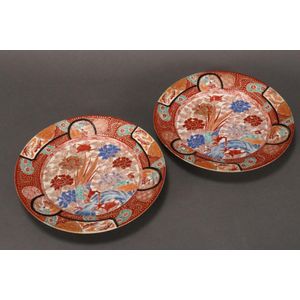Kutani Peacock Plates (Pair)
Pair of Japanese Edo period Kutani plates, of circular form, decorated with a central scene of peacock and flowers, surrounded by panels of flowers, butterflies and foliage, in rich tones of iron red, blue, gilt and green, character marks to base, diameter 22 cm (2)
You must be a subscriber, and be logged in to view price and dealer details.
Subscribe Now to view actual auction price for this item
When you subscribe, you have the option of setting the currency in which to display prices to $Au, $US, $NZ or Stg.
This item has been sold, and the description, image and price are for reference purposes only.
- Edo Period, Japan - The Edo period in Japan lasted from 1603 to 1868. During this time, Japan was ruled by the Tokugawa shogunate, a military government led by the Tokugawa family. The Edo period is characterized by a period of relative peace, stability, and economic growth, as well as by the development of a distinctive culture and society.
During the Edo period, the capital of Japan was moved from Kyoto to Edo (modern-day Tokyo), and the country became increasingly isolated from the rest of the world. The shogunate implemented strict policies to maintain control, including the restriction of foreign trade and travel. However, despite this isolation, the Edo period saw significant cultural and artistic development, including the emergence of the ukiyo-e woodblock print tradition, the growth of Kabuki theater, and the flourishing of a vibrant merchant culture.
The Edo period ended with the Meiji Restoration of 1868, which saw the collapse of the shogunate and the restoration of imperial rule.
This item has been included into following indexes:
